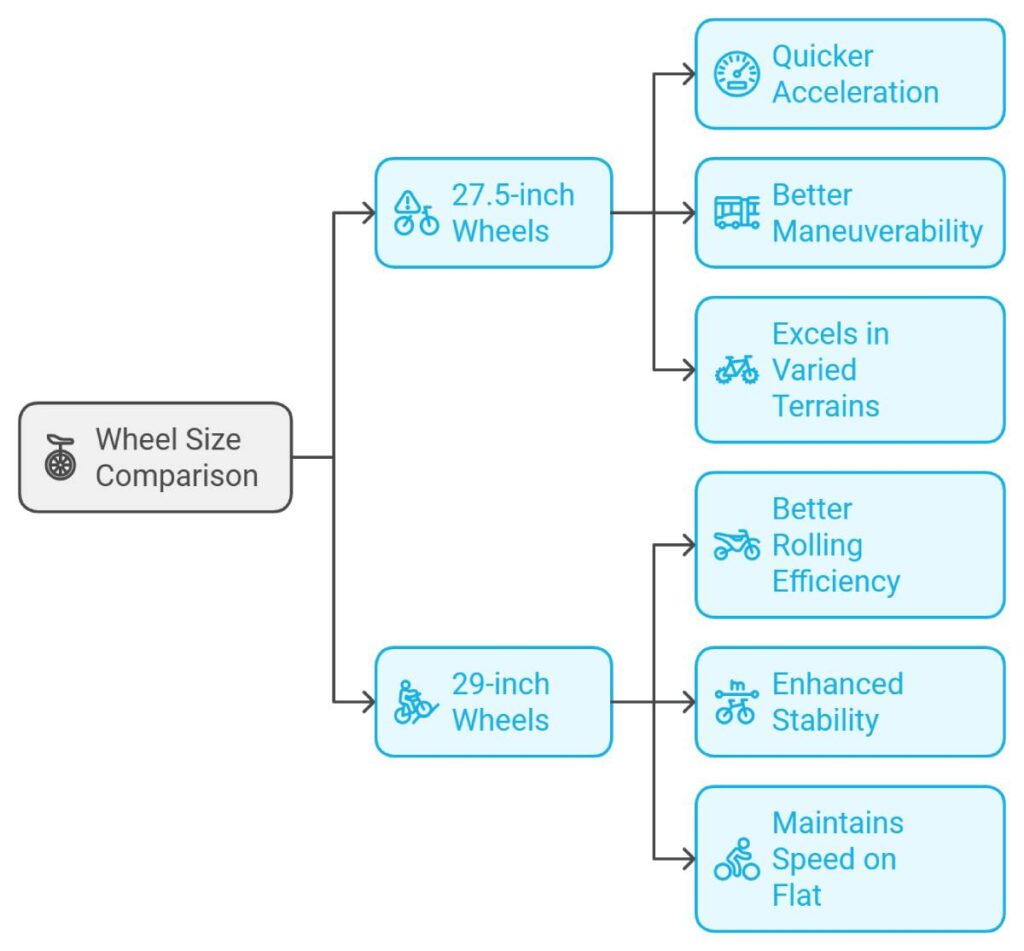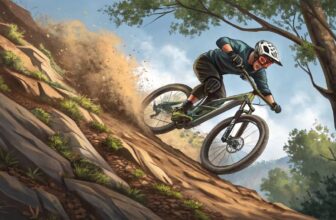Are you standing at the trailhead, torn between the nimble 27.5-inch and the towering 29er mountain bikes? Choosing the right wheel size isn’t just a fleeting decision—it’s the key to unlocking your ultimate riding experience.
Whether you’re chasing speed, seeking stability, or craving that perfect balance, understanding the battle between 27.5 and 29-inch wheels can transform your ride from ordinary to extraordinary.
Let’s dive into the showdown and help you find your perfect match on the trails!
Wheel Size Showdown
Mountain bikers and fresh faces in the biking community often find themselves at a crossroads: Should they go with a nippy 27.5-incher or a lofty 29er? Deciding on a wheel size ain’t just some random choice; it’s a big deal.

Wheel Size and Speed Myth Busted
Think bigger wheels mean you’re zooming faster? Not exactly! Loads of research give that claim the old heave-ho. Rod Bikes points out that a bike’s wheel size doesn’t determine its speed.
Whether it’s a road bike with 26-inch wheels or one with 700c wheels, they can clock similar speeds thanks to “gear inches”—a geeky way to measure how far you roll with each pedal spin. And fun fact: every bike speed record ever was nailed on tiny wheels, flipping the big-wheel-speed myth on its head.
Wading Through Wheel Size Effects
While speed doesn’t depend on wheel size, plenty else does. So let’s break it down:
| Wheel Size | Get Up and Go | Grip | Keeping Pace | Best For |
|---|---|---|---|---|
| 27.5-inch | Quick to launch | Decent | Needs hustle | Agile, zippy spins |
| 29-inch | Sluggish but steady | Grippy champ | Rolls easy | Long, bumpy trips |
- Get Up and Go: According to REI, those 27.5-inch wheels are the sprinters in this race. Their quick acceleration makes them a blast for riders who like that buzz of a zippy journey.
- Grip: Meanwhile, the 29-inch wheels are your go-to for grip, boasting a bigger patch on the ground. When it comes to slick rocks and stubborn roots, they’re the steady pair you want.
- Keeping Pace: 29ers rule the roost in this department, needing less power to roll on and on. Great for those long rides where you just want to cruise.
Different wheels, different feel. Riders pick their gear, not just based on terrain but their own shape and size, too. Taller riders might find bigger wheels a better fit, for example.
By sorting fact from fiction, mountain bikers can really nail the right wheel size. Interested in dialing up your bike game? Check out tips on mtb tire pressure or gear up with mountain biking basic skills.
Evolution of Mountain Bike Wheels
Mountain biking has been riding on the winds of change, with wheel sizes evolving over time to jazz up the riding thrill and performance. Let’s dig into what makes the 27.5-inch and 29-inch (or 29er) wheels a big deal for anyone eager to gear up and hit the trails.
Introduction of 27.5-inch Wheels
When the 27.5-inch (650B) wheels rolled onto the scene, they were a game-changer, nudging the trusty ol’ 26-inch wheels off the main stage. These wheels hit the sweet spot – offering the bounce of little wheels with a dash of the perks you see in the big boys, which means better roll-over action, solid grip, and more air cushion than the 26-inch tires ever could.
Bike makers got folks talking about the 27.5-inch wheels as the lively ones, super easy to control, and still packing some of the cool stuff you’d get from a 29er. Their lightweight and tough design got kudos from riders who love zipping through trails without breaking too much of a sweat.
Dominance of 29-inch (29er) Wheels
29ers, that’s the nickname for 29-inch wheels, pretty much own the spotlight in mountain biking circles. They’re built for gripping the trail tight and bulldozing over tricky spots, giving you a smoother and steadier ride. Thanks to their girth and extra air space, they’re a hit for those epic bike adventures and cross-country jaunts.
These wheels love to keep moving and help you zoom by holding momentum like a boss, especially when the trail stretches out ahead. Their big surface area means better grip, nailing rides uphill, around corners, or when you slam the brakes. This makes them a go-to for those wild terrains and gnarly paths.
Comparative Overview
Here’s a handy rundown of how the 27.5-inch and 29-inch wheels stack up:
| Feature | 27.5-inch Wheels | 29-inch (29er) Wheels |
|---|---|---|
| Agility | Super agile and lively | More steady than sharp |
| Roll-over Ability | Solid – beats the 26-inch for sure | Tops the chart, eats up rocks and roots for breakfast |
| Traction | A step up from smaller wheels | Top-notch due to more ground contact |
| Momentum Maintenance | Just right for mixing pace with control | Stays fast, shines on long hauls and mixed paths |
| Weight and Strength | Lighter and tougher than the 29ers | Heavier weight but trades this for beefed-up stability |
For more biking hacks, check out our articles on mtb gear ratios and mtb suspension setup to squeeze every drop of joy on your spinning adventures.
Wheel Design Factors
When picking between a 27.5 or 29er MTB, don’t just focus on wheel size—think about all the bits that affect how the bike rides and lasts. Two biggies to keep in mind are how the rims are made and the material of the spokes.
Influence of Rim Width and Shape
These days, mountain bike rims got a little wider, bringing some serious advantages to the riding table. Wider rims mean you can have a bigger tire air volume, making your ride more cushiony while riding on lower pressures. It improves how your bike grips the ground and gives you more control, which is pretty handy when you’re wrestling with tricky trails.
| Rim Type | Width (mm) | Good Stuff |
|---|---|---|
| Narrow Rim | 19-25 | Light on weight, goes smooth and fast |
| Wide Rim | 26-35+ | Holds to the ground like glue, comfy ride |
The rim’s shape and depth also play their part. While you might not be obsessed with rim depth like road riders, it still matters. Deeper rims can handle more side stress, which is a win if you’re into riding that pushes the limits.
Importance of Spoke Count and Material
The number of spokes in a wheel can say a lot about how strong and tough it is. The front wheel typically has between 24-28 spokes, while the back one has 28-32. More spokes make a wheel sturdier, but they also weigh it down a bit—a bummer if you’re chasing a feather-light setup.
| Position | Spoke Count | Upside | Downside |
|---|---|---|---|
| Front | 24-28 | Light as a feather, just strong enough | Not tank-like |
| Rear | 28-32 | Tough and strong willed | On the hefty side |
Spokes come in different materials, each bringing its bag of traits. Some of the usual suspects are:
- Steel: Tough and doesn’t break the bank, but it’s on the heavy side.
- Aluminum: Light, shrugs off rust, less tough than steel.
- Carbon Fiber: Has that weightless feel, very strong, but costs a pretty penny.
- Titanium: Light yet bulletproof—if you can afford it.
Pairing the right rims and spokes can jazz up your bike’s performance, changing how durable the ride is and how comfortable you feel cruising. Be sure to check out our guide on mountain bike maintenance for even more nitty-gritty details on specs.
Choosing the right wheels? Think about how all these things line up with the kind of riding you’re into. Do you crave speed, grip, or rock-solid stability? Knowing these pieces will help you make the right call between 27.5 and 29er wheels. For a deeper dive into how the size of your wheels shifts your ride vibe, check out our insights on MTB suspension setup and MTB tire pressure.
Comparing 27.5 vs. 29er
Deciding between 27.5-inch and 29-inch wheels is no small feat for mountain bikers. Each size brings its own flair to the trails, touching everything from how fast you go to how well you stick to the ground. Let’s break it down and see what each has to offer.
Performance in Acceleration
When it comes to quick starts—crucial for those adrenaline-pumping climbs or sprints—wheel size matters.
- 27.5-inch Wheels: Think of these as the sprinters of the bike world. Their smaller size makes them light, giving you that boost of speed right when you need it. Great for tight, twisty trails where quick maneuvers are key (REI).
- 29-inch Wheels: While they might take a bit to get going due to their heft, once they’re rolling, they keep on going. This makes them a favorite for those long rides where efficiency is everything—ideal for racing or endurance treks.
| Wheel Size | Acceleration | Momentum |
|---|---|---|
| 27.5″ | Fast | Needs More Power |
| 29″ | Slow Start | Keeps Rolling |
Traction and Stability Comparison
Keeping your wheels firmly planted is crucial for tackling all sorts of terrain.
- 27.5-inch Wheels: These wheels give you the best of both worlds, with a solid grip and nimbleness to tackle varied terrains. Perfect for a mix of trail, all-mountain, and enduro riding.
- 29-inch Wheels: The big boys on the block, cover more ground, providing a larger footprint. That means better grip, especially when the going gets tough—think slippery rocks or tangled roots. They also lend a hand when it comes to turning or stopping on a dime.
| Wheel Size | Grip | Stability |
|---|---|---|
| 27.5″ | Solid | Fair |
| 29″ | Exceptional | Strong |
Knowing how wheel sizes change the game helps you make the right pick. Want to know which size fits your height? Check out our mountain bike sizing guide. Curious about tire pressures? We’ve got tips on that too in our MTB tire pressure piece. Think about your style and trails, and you’ll find the wheel that fits you like a glove.
User Experience Insights
Height and Wheel Size Preference
When choosing between 27.5″ and 29″ mountain bike wheels, how tall you are is a biggie. Those 29 inches tend to work better for folks on the taller side. Why? Because those large wheels can change up the bike’s fit, it is a bit of a puzzle for shorter people to get comfy on a 29er (REI). On the flip side, the 27.5″ bikes are generally the go-to for shorter riders, as they seem less clunky when you’re carving up the trail.
But remember, your height isn’t the only thing to think about. The bike’s fit and how it feels under you are just as crucial. Taller riders might lean toward a 29er for long rides across bumpy terrains for that comfy ride. Meanwhile, folks who are a bit on the smaller side might appreciate the nimbleness and control of a 27.5″.
| Rider Height (ft) | Recommended Wheel Size |
|---|---|
| Under 5’5″ | 27.5″ |
| 5’5″ – 6’0″ | 27.5″ or 29″ (personal vibe checks) |
| Over 6’0″ | 29″ |
Competitiveness in Long-Distance Riding
When it comes to logging those long miles, the choice between 27.5″ and 29″ wheels can change up your ride in terms of both speed and comfort. Those 29ers have a knack for smoothing out the ride over gnarly obstacles like logs and rocks, thanks to their ability to power over things with less effort. This makes them a top pick for really rocky trails, turning a bumpy ride into something more like a glide.
Places like the rough trails of the Peak District are great for testing out those 29″ wheels—they’ll keep you cruising over bumps and tricky surfaces. That’s great news for competitive riders or anyone who loves to tackle tough trails regularly.
| Terrain Type | Preferred Wheel Size |
|---|---|
| Rocky/Bumpy | 29″ |
| Smooth/Gravel | 27.5″ or 29″ |
In the end, picking the right wheel size is all about your personal style and what you need from your ride. If you’re after tips on hooking up the best wheel and tire combos for your needs, be sure to check out our suggestions for mountain bike frame sizes and MTB tire pressure.
Technical Considerations
Impact of Wheel Size on Speed
When eyeballing 27.5-inch wheels against the 29-inch variety, speed’s the hot topic. Let’s break it down. Acceleration’s the first player here. A shoutout to REI for pointing out that those 27.5-inch wheels, a.k.a. 650B, zip off the line faster. This quickness gives bikes a snappy, lively touch that thrills many riders, especially on twisty trails.
Now, don’t count out the 29-inch champions. Sure, they’re slow out of the gate, but their secret sauce is momentum. Known as “rolling efficiency,” this means once they get going, they stay going with less effort. That’s why they’re the cool kids at long-distance and endurance riding parties.
But hey, wheel size ain’t the sole speed boss. Other stuff like weight, how responsive the bike is, and the gears all mix into the speed stew. Looking for more speed spice? Check out our write-up on mtb gear ratios.
| Feature | 27.5-inch Wheels | 29-inch Wheels |
|---|---|---|
| Acceleration | Quicker | Slower |
| Rolling Stamina | Lower | Higher |
| Nimbleness | High | Moderate |
Terrain-Specific Wheel Advantages
Where you ride can totally change the game on which wheel size wins for you. Each has its top scores depending on the dirt under your tires.
27.5-inch Wheels:
- Technical Twists & Tight Turns: Smaller diameters help your bike zip around turns and tackle tricky trail sections like a champ.
- Climb Power: Quick speed bursts make these wheels rock stars on steep or sudden climbs.
29-inch Wheels:
- Bumpy and Rocky Roads: They steamroll over bumps and rough spots, serving up a smooth ride on rugged trails. They keep you cruising and help cut the tiredness on marathon rides.
- Downhill Zoom: More stable when tearing downhill, perfect for those who crave speed and smooth sailing on fast descents.
Picking the perfect wheel size is often about what feels right for you and where you ride. For setting up your bike just right for any trail, zoom over to our piece on MTB suspension setup.
To wrap it up, 27.5-inch wheels are your go-to for quick starts and tight maneuvers on tricky trails. Meanwhile, 29-inch slabs excel in keeping up speed and give a firm, even ride over rougher patches. Think about your ride style and the ground you cover to find your ideal size. Don’t forget critical elements like MTB tire pressure and mountain bike maintenance to keep your ride rolling smoothly and long-lasting.
Riders’ Perspectives
Personalized Wheel Size Selection
Picking between 27.5-inch and 29-inch wheels for mountain bikes is all about what feels right to you. Many bikers say that how a bike fits and feels is key to their choice.
- Fit and Feel: On the trails, 27.5-inch wheels might seem less bulky to shorter folks, giving a quicker and more agile experience. On the flip side, tall riders lean towards 29 inches since they often feel more comfortable with that extra height.
- Riding Style: Some bikers prefer the ease of maneuvering with 27.5-inch wheels, while others rave about how 29ers handle rough spots.
- Personal Preference: Beyond just fit, it’s all about how you like your bike to handle, its weight, and the way it’s put together. The kind of trails and ground you usually tackle also play a part in your choice.
At the end of the day, go with what feels right for you. If you’re interested in tuning your bike just right, check out our article about mountain bike sizing.
Influence of Rider Height on Wheel Choice
Height is a biggie when picking wheel sizes, but it’s not the whole story. Here’s how height stacks up in wheel selection:
| Rider Height | Suggested Wheel Size |
|---|---|
| Under 5’2″ | 26-inch |
| 5’2″ to 6’2″ | 27.5-inch |
| Over 6’2″ | 29-inch |
- Short Riders: If you’re under 5’2″, those 26-inch wheels might just feel right.
- Average Height: If you’re somewhere between 5’2″ and 6’2″, a 27.5-inch wheel blends maneuvering and rolling pretty nicely.
- Taller Riders: Over 6’2″? The 29-inch wheels usually work better for bigger frames and give a smoother vibe. Someone who’s 6ft 3in might find the 29er most comfy.
Rider Preferences
Your height isn’t the only thing to think about when choosing wheel size. The bike’s geometry, terrain types, and your riding quirks all matter, too. For example, some riders in long-distance races say that bike differences often boil down to fitness and style choices.
Before you pull the trigger on a choice, try both wheel sizes. See what clicks for you. Our guide on mountain biking essentials offers more handy tips to guide your pick.
For more techie stuff, take a peek at our articles on MTB gear ratios and our DIY mountain bike repairs to keep you rolling smoothly.
Wheel and Tire Recommendations
Picking the right wheels and tires isn’t just for when it’s nice out—it’s a whole mountain biking lifestyle. Whether you’re diving headfirst into the world of biking or you’ve been cruising trails for ages, this guide has you covered. Let’s cut through the noise and help you pick tires and wheels that’ll actually make a difference.
Optimal Tire Choices
Tires are the unsung heroes of your mountain bike. Get the right one, and you’re a trail legend; get it wrong, and, well, let’s not even go there. Think about how you’ll be riding before you buy. Here’s your cheat sheet for 27.5″ and 29″ tires:
27.5″ Tires (650B)
27.5-inch tires strike that sweet spot between ease of tooling around and being able to really cruise. Imagine you’re gliding over rocks without a hitch:
- Trail Riding: Lets you twist and turn through tricky trails like a pro.
- All-Mountain Riding: Finds the middle ground for control and quick response.
- Enduro Biking: Designed for when you need both sturdiness and a quick reaction to tough tracks.
| Riding Style | Tire Size | Why You’ll Love It |
|---|---|---|
| Trail Riding | 27.5″ | Moves like a ninja with control |
| All-Mountain | 27.5″ | Handles it all smoothly |
| Enduro | 27.5″ | Built for rough adventures |
29″ Tires
29-inchers are a different breed, giving you that extra momentum and grip. Do you want to fly through trails while ensuring no nasty surprises? This is your tire:
- Cross-Country: Zips along with ease and speed.
- Marathon Riding: Offers comfort so obstacles are just a bump in the ride.
- Trail Riding: Grips like glue on all kinds of surfaces.
| Riding Style | Tire Size | Why You’ll Love It |
|---|---|---|
| Cross-Country | 29″ | Better flow and speed |
| Marathon | 29″ | Like cruising on a cloud |
| Trail Riding | 29″ | Extra grip and control |
Patch up your ride knowledge with more intel on tire pressure and maintenance here: mtb tire pressure and mountain bike maintenance.
Carbon vs. Aluminum Wheel Performance
Now, let’s get to the wheels. Making a choice between carbon and aluminum is like deciding between two contrasting personalities: one’s flashy and one’s reliable.
Carbon Wheels
Carbon wheels are the sleek racing cars of the MTB world. They have their quirks but make up for it in performance:
- Lighter Weight: Gives you the upper hand on hills like you’ve got hidden wings.
- Stiffness: Turns your strength into top performance without a second’s delay.
- Durability: Not as robust by nature, but modern ones are much tougher.
Aluminum Wheels
Aluminum’s the friend that’s always there – they keep it simple but sturdy:
- Durability: Take a beating and get back up without complaint.
- Cost-Effective: Doesn’t hurt the bank as much.
- Weight: A bit heftier, meaning they can slow you down a tad.
| Feature | Carbon Wheels | Aluminum Wheels |
|---|---|---|
| Weight | Floaty | Solid |
| Durability | Modern Tough | Barely Breaks |
| Cost | Pricier | More Bang for your Buck |
| Performance | Speed Demon | All-Around Steady |
Figuring out these quirks means you can go with what suits your budget and ride style best. Geek out more on the wheel topic with tubeless mtb setup and how to true mtb wheel.
By keeping these pointers in mind, you’ll have what you need to make the right call for your biking exploits. For even more wisdom on mountain bike good stuff, head over to our mtb upgrade priority. Happy trails!
Conclusion
In the exhilarating clash between 27.5-inch and 29er mountain bike wheels, there’s no one-size-fits-all winner.
Your choice hinges on your riding style, terrain preferences, and personal comfort. Whether you crave the swift agility of the 27.5s or the steadfast stability of the 29ers, both wheel sizes offer unique advantages to elevate your biking adventures.
By understanding the nuances of speed, grip, and rider experience, you can confidently select the wheels that best complement your trail ambitions.
Gear up, hit the trails, and let your perfect wheel size propel you to new heights of mountain biking mastery!
Frequently Asked Questions (FAQs)
What are the main differences between 27.5-inch and 29-inch mountain bike wheels?
The primary differences lie in agility, grip, and rolling efficiency. 27.5-inch wheels offer quicker acceleration and nimbleness, making them ideal for tight trails and technical maneuvers. In contrast, 29-inch wheels provide better traction and momentum maintenance, suitable for long-distance rides and rough terrains.
Which wheel size is better for beginners?
Both sizes can be suitable for beginners, but 27.5-inch wheels might offer easier handling and quicker responsiveness, helping new riders build confidence on various trails.
How does rider height influence the choice between 27.5 and 29-inch wheels?
Taller riders often prefer 29-inch wheels for a more comfortable fit and smoother ride, while shorter riders may find 27.5-inch wheels more manageable and less bulky.
Do wheel size differences affect tire choices?
Yes, each wheel size typically pairs with specific tire types optimized for performance. 27.5-inch wheels often use tires designed for agility, while 29-inch wheels use tires that enhance grip and rolling efficiency.
Can I switch from 27.5-inch to 29-inch wheels on my current bike?
It depends on your bike’s frame and fork clearance. Some bikes are designed to accommodate both sizes, but it’s essential to consult with a professional or refer to your bike’s specifications before making the switch.




